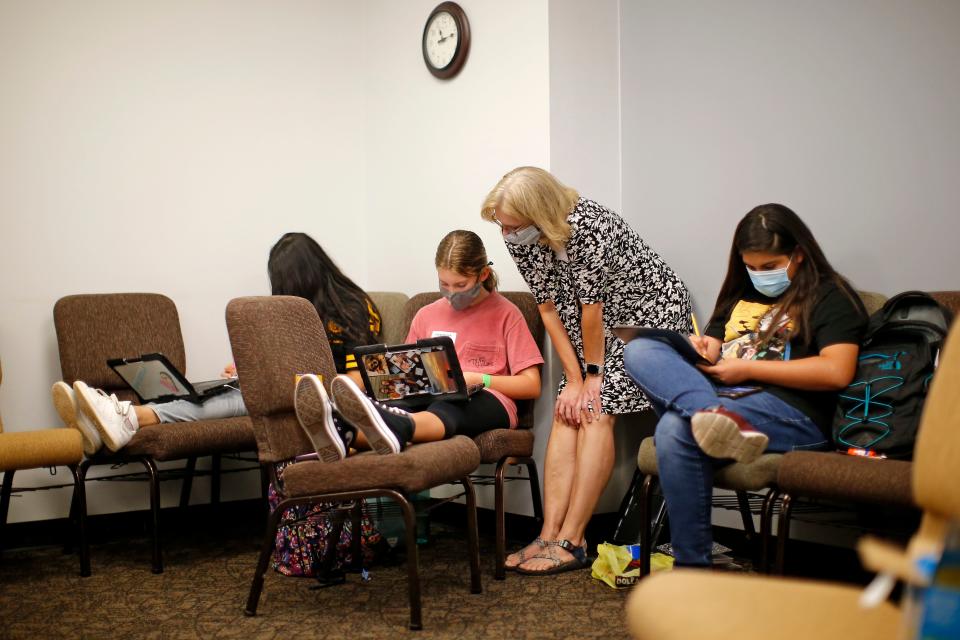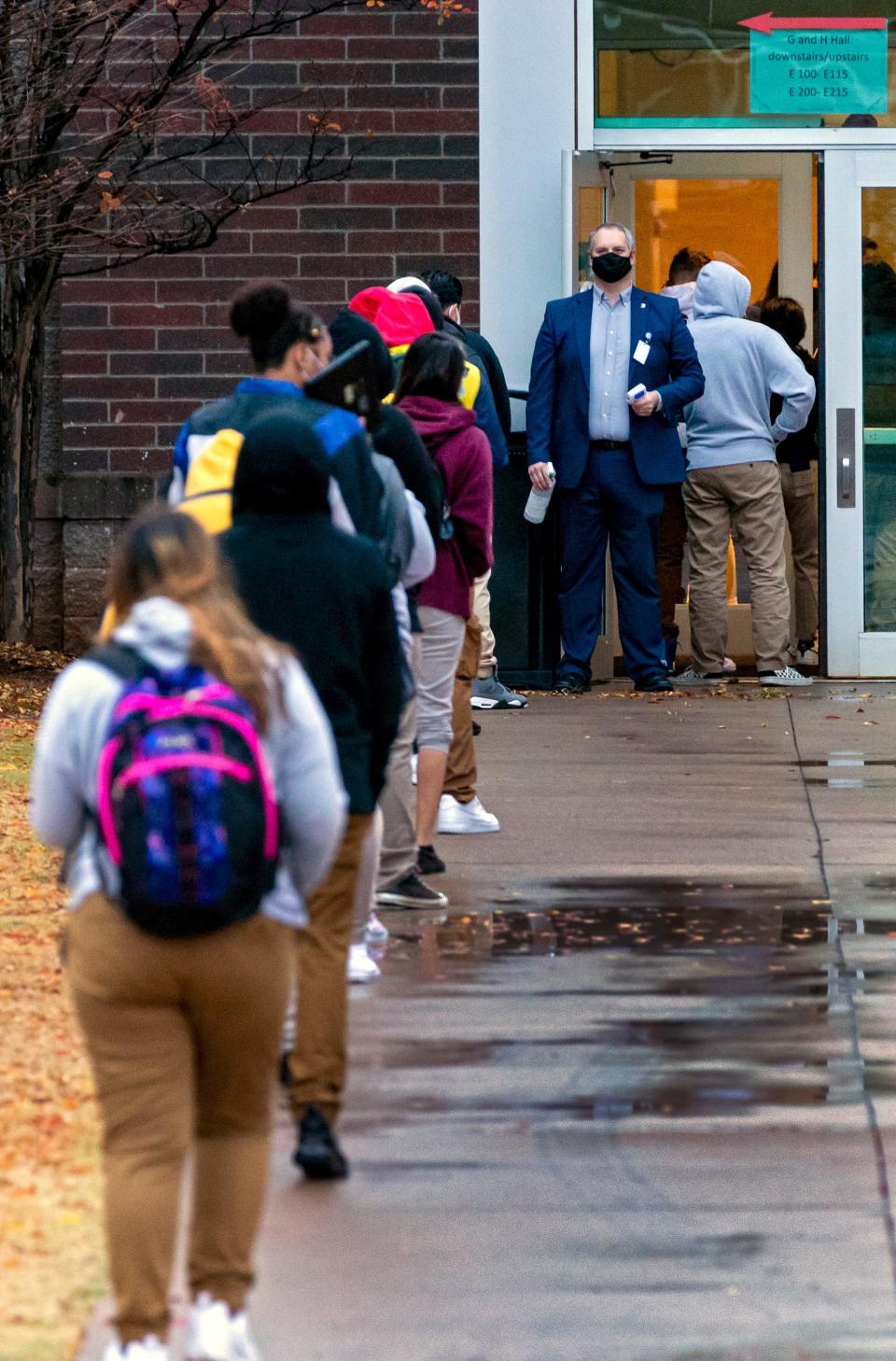Most Oklahoma students are behind despite 2022 growth, test scores show
New testing data shows Oklahoma students made small academic gains last school year, but most are still behind in reading, math and science.
The Oklahoma State Department of Education on Friday released 2022 results of state tests, which public school students take in third through eighth grade and 11th grade.
The number of students who scored at their grade level increased for each age group and subject area with two exceptions. A half percent fewer high school juniors were proficient in math, and 2.58% fewer eighth-graders showed grade-level mastery of science.
A quarter of Oklahoma students scored on level in math, 27% hit grade-level targets in reading and 31% did so in science.
These results indicate the majority of test takers scored at a basic level, indicating partial mastery of a subject, or below basic. Students who score below basic are not on track for college and career success, the state Education Department said.
Scores improved from 2021, but they're still below pre-pandemic results.
In the 2018-19 school year, the last not to be interrupted by COVID-19, 32% of students were proficient or advanced in math, 34% had a strong grasp on reading and 35% did in science, state data shows.
State schools Superintendent Joy Hofmeister said this year’s gains over the year before are “encouraging.” She said 2021 results set a new baseline for student performance after COVID-19 caused widespread disruptions in schools.
“The spring 2022 scores show that our students are turning a corner in academic achievement,” Hofmeister said in a statement. “In light of more than two school years of COVID-related instructional challenges and interruptions, these results show that local and statewide recovery and academic acceleration investments are clearly having a positive impact.”
Oklahoma closed schools statewide for the final quarter of the school year in 2020 after community spread of the novel coronavirus was detected that spring.
Schools mostly reopened the following August, though some urban districts remained in virtual learning until January 2021. Despite returning to full in-person instruction in the 2021-22 school year, many students, teachers and even entire districts missed class time for quarantine.
State tests were canceled in 2020, and participation was lower than usual in 2021. Only 92% of Oklahoma students took state tests last year, below the 95% threshold for a representative sample, because the federal government didn’t consider spring assessments mandatory.
Participation rebounded to 98% this spring. State report card results, which detail other measures of school performance, will be released later this fall, state officials said.
COVID-19 impact on learning had national implications
Academic growth suffered nationwide during the pandemic era. From 2020 to 2022, 9-year-olds across the country showed the largest reading score decline since 1990 and the first score drop in math since 1973, according to nationwide assessments from NAEP, known as the Nation’s Report Card.
“This pandemic has been like an earthquake; it shook our world, and education will never be the same,” said Peggy Carr, commissioner of the National Center of Education Statistics, which oversees NAEP evaluations.
Remote instruction, in lieu of in-person classes, had “profound consequences” for student achievement, according to a study of 2.1 million U.S. schoolchildren published by the Harvard University Center for Education Policy Research.
“In districts that went remote, achievement growth was lower for all subgroups (of students), but especially for students attending high-poverty schools,” researchers wrote in the report.

Areas where schools stayed in-person experienced modest losses in achievement during COVID-19, researchers said. But, reading score gaps between high- and low-poverty schools widened less than in remote-learning districts and didn’t widen at all in math.
Oklahoma children in third through eighth grades scored on level in English Language Arts at a rate of only 22% to 29%, 2022 results show.
More than 38% of high school juniors were proficient or advanced in reading, having improved by 8.47% since 2021, the largest improvement margin of any tested subject and grade.
Thirty-three percent of third- and fourth-graders hit grade-level targets in math, but numbers worsened among older children. Students in fifth, sixth and seventh grade scored on level at a rate of 22-26% while 16% of eighth-graders and 19% of 11th-graders showed math proficiency.
Only fifth, eighth and 11th grades take state assessments for science. Fifth-grade science scores showed the second-largest gain of any grade level and subject area. Five percent more fifth-graders reached proficiency in science this year.
Thirty-seven percent of fifth-graders, 30% of eighth-graders and 25% of 11th-graders were on level or above in science.

School districts in the Oklahoma City metro area say they built remediation time into the school day to recover lost progress.
Students as young as 8 or 9 are tracking their individual academic progress and set learning goals in Oklahoma City Public Schools.
Oklahoma City school officials estimate students fell two years behind for every school year the district had long stretches of remote instruction.
That’s about four years of ground to make up, Gena Koster, assistant superintendent of teaching and learning, told The Oklahoman last month.
“The anxiety and pressure that comes with learning loss is real,” Koster said. “They come back, and it doesn’t come as easily as what it might have before.
“They’re going to have to take ownership of that and create their own goals and work with us to get them to a better place.”
Reporter Nuria Martinez-Keel covers K-12 and higher education throughout the state of Oklahoma. Have a story idea for Nuria? She can be reached at nmartinez-keel@oklahoman.com or on Twitter at @NuriaMKeel. Support Nuria’s work and that of other Oklahoman journalists by purchasing a digital subscription today at subscribe.oklahoman.com.
This article originally appeared on Oklahoman: Oklahoma test scores show student growth, but many are still behind

